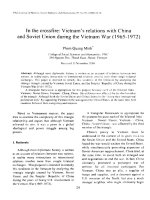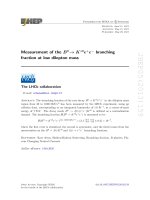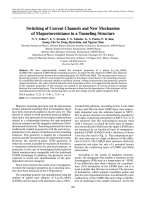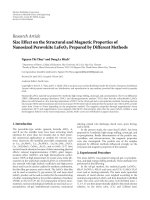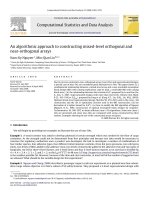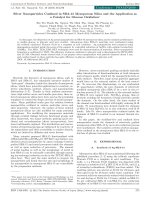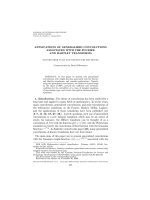DSpace at VNU: Rare Earth-Doped BiFeO3 Thin Films: Relationship between Structural and Magnetic Properties
Bạn đang xem bản rút gọn của tài liệu. Xem và tải ngay bản đầy đủ của tài liệu tại đây (167.21 KB, 8 trang )
Advances in Condensed Matter Physics
Volume 2015 (2015), Article ID 371802, 5 pages
/>Research Article
Rare Earth-Doped BiFeO3 Thin Films: Relationship
between Structural and Magnetic Properties
Ngo Thu Huong,1,2 Seunghun Lee,3 Timur Sh. Atabaev,1 Makio
Kurisu,4 and Nguyen Hoa Hong1
1
Nanomagnetism Laboratory, Department of Physics and Astronomy,
Seoul National University, Seoul 08826, Republic of Korea
2
Faculty of Physics, Hanoi University of Science, 334 Nguyen Trai,
Thanh Xuan, Hanoi, Vietnam
3
Department of Materials Science and Engineering, University of
Maryland, College Park, MD 20742, USA
4
Department of Physics, Graduate School of Science and Engineering,
Ehime University, Matsuyama 790-8577, Japan
Received 18 March 2015; Accepted 19 August 2015
Academic Editor: David Huber
Copyright © 2015 Ngo Thu Huong et al. This is an open access article
distributed under the Creative Commons Attribution License, which
permits unrestricted use, distribution, and reproduction in any medium,
provided the original work is properly cited.
Abstract
Rare Earth- (RE-) doped BiFeO3 (BFO) thin films were grown on
LaAlO3 substrates by using pulsed laser deposition technique. All of
BFO films doped with 10% of RE show a single phase of
rhombohedral structure. The saturated magnetization in the Ho- and
Sm-doped films is much larger than those reported in literature and
was observed at a quite low field as of 0.2 T. As for Pr- and Nd-doped
BFO films, Fe2+ amount is not dominant; thus, ferromagnetism is not
favored. As the RE concentration goes up to 20%, all compounds have
drastically gone through a structural transition. The RE-doped BFO
films have changed from rhombohedral to either pure orthorhombic
phase (for Ho, Sm), or a mixed phase of orthorhombic and tetragonal
(for Pr, Nd), or pure tetragonal (for Eu). We observed magnetic
properties of RE-doped BFO films have significantly changed. While
20% Ho/Sm-doped BFO films have ferromagnetism degraded in
comparison with the 10% doping case, the 20% Pr/Nd-doped BFO thin
films, whose structure is a mixed phase, have magnetic ordering
improved due to the fact that the Fe2+ amount has become greater. It
seems that one can control the magnetic properties of BFO films by
using appropriate RE dopants and concentrations.
1. Introduction
BiFeO3 (BFO) is a promising multiferroic material due to its high
ferroelectric and antiferromagnetic ordering temperatures. Generally,
BiFeO3 has G-type antiferromagnetic due to the local spin ordering of
Fe3+ that basically forms a cycloidal spiral spin structure. In order to
make BFO be room temperature ferromagnetic to be used in industrial
applications, people have tried to suppress the spiral magnetic ordering
by applying a very high magnetic field, or making them nanostructured,
or by replacing Bi3+ or Fe3+ by other ions of comparable ionic sizes
[1, 2]. Dimension reduction is likely to be a good way to improve the
magnetization in BFO [3, 4]. Some groups have reported about the
increase of magnetization in the bulk, thin films, and nanoparticles of
BFO, by substituting either on the Bi-site by trivalent rare earth and
divalent ions or on the Fe-site by transition metal ions [5, 6]. Some
groups had showed that the magnetic moment of the nanoparticles
could be increased three times by substituting Bi by Sr, or Ho.
However, the reported saturated magnetization is found only at very
high fields as of 5 T [2] and 6 T [1], respectively.
Our study focuses on tailoring the magnetic properties of BiFeO3 by
choosing the appropriate RE ion for substitution and selecting the
appropriate concentration, in order to obtain the largest magnetization
possible at room temperature, at relatively low fields. Understanding
the structure dependence of magnetic properties of RE-doped BFO
films is of utmost importance in order to tune the magnetism of this
type of materials to match up the requirements of applications.
2. Experiment
ceramic targets (where RE = Ho, Sm, Pr, Nd, and Eu; , 0.1, and 0.2)
were prepared by a sol-gel method. Rare earth- (RE-) doped
BiFeO3 (RBFO) thin films have been fabricated by pulsed laser
deposition (PLD) technique (excimer KrF laser with nm; the repetition
rate was 13 Hz and the energy density was 2.1 J/cm2), with typical
thicknesses as of 200 nm. All the films were grown on (001)
LaAlO3 (LAO) substrates. During deposition, the substrate temperature
was kept at 700°C and the oxygen partial pressure () was 1.4 ×
10−3 Torr. After deposition, the sample was kept in the chamber at
500°C with the same oxygen partial pressure as during deposition for
30 min and then finally cooled down slowly to room temperature.
The structural analysis was done by high resolution X-ray diffraction
(HRXRD) with Cu Kα radiation. The magnetic measurements were
performed by a Quantum Design Superconducting Quantum
Interference Device (SQUID) system under magnetic field () from 0 up
to 0.5 T under a range of temperatures () from 350 K down to 5 K.
The surface chemistry and composition of RE-doped BFO thin films
were characterized by X-ray photoelectron spectroscopy (XPS,
KRATOS, and AXIS-HSi). XPS measurements were performed with
an Mg/Al X-ray source. The energy calibrations were made against the
C 1s peak and the Shirley background subtraction was used.
3. Results and Discussion
Concerning structure, for the case of 10% of RE substituted for Bi in
BFO, there is no significant change in comparison to the pristine
BiFeO3 [7]. Our laser ablated RE0.1Bi0.9O3 films are single phase
rhombohedral R3c. Doping with different RE elements only causes
some shift of the BFO peak positions, indicating some change in lattice
parameters. The out-of-plane parameters are 3.925, 3.925, 3.9329,
3.933, and 4.585 Ǻ for Sm, Ho, Nd, Pr, and Eu doping, respectively.
One can notice here that the Eu doping distorts the structure the most
(see details in Table 1), if we compare with parameters of the undoped
BiFeO3 [8].
Table 1: List of structural phases, lattice parameters, and
Fe2+ : Fe3+ ratio for REBiFeO3 films (RE = Ho, Sm, Eu, Pr, and Nd; =
0.1 and 0.2).
When the RE doping concentration increases up to 20%, a structural
transition has occurred. When doping Ho and Sm up to 20%, the
structure has become single phase orthorhombic, while for Pr and Nd,
it has turned to be a mixture of orthorhombic and tetragonal phases.
For Eu doping case, it is single phase tetragonal. A representative
feature of X-ray patterns for RE-doped BFO films is shown in Figure 1.
In order to make it easier to have an overall picture, we list the
structure types as well as parameters for all of thin films in Table 1. It
is known that changing dopant concentration can lead to a structural
transition, as reported in [5, 6, 9]. Normally for concentration of RE
greater than 0.2, the orthorhombic phase is likely favored [5, 9, 10].
Figure 1: X-ray diffraction patterns for 200 nm-thick films grown on
LaAlO3 substrates of (a) Nd0.1Bi0.9FeO3, (b) Nd0.2Bi0.8FeO3, and (c)
Eu0.2Bi0.9FeO3.
Magnetization versus magnetic field taken at 300 K for
RE0.1Bi0.9O3 film was reported in [7]. Our new result for Eu-doped BFO
films (shown in Figure 2) reveals a strong ferromagnetic behavior that
is quite similar to those of Sm-doped and Ho-doped BFO films.
Previously, some ferromagnetic ordering in Ho-doped BFO was
reported, however, with a much smaller magnitude, and was obtained
at much larger field (as of 6 T) [1], while ours has a larger , but at a
much lower field (as of 0.2 T), as seen in Figure 3(a). While other
groups reported paramagnetic behavior for Eu-doped BFO ceramics
[10], as seen in Figure 2, our Eu-doped BFO film is room temperature
ferromagnetic at 0.2 T. This should be quite advantageous for
applications. Comparing to Ho-, Sm-, and Eu-doped BFO films, then
the Pr- and Nd-doped BFO films show much smaller magnetic
moments. As seen in Figure 3(b), the typical M-H curves of Pr-doped
BFO (10%) taken at room temperature are almost linear, showing a
paramagnetic behavior. In Figures 3(a) and 3(b), one can also see the
obvious difference in magnetic properties for samples of 10% and 20%
doping of RE. As for Ho, when doping 10%, because the
Fe2+ : Fe3+ ratio is 50% : 50% (see Table 1), the ferromagnetic phase is
more favored. When doping 20% of Ho, the Fe2+ amount is decreased
(45.6%, shown in Table 1); then, the ferromagnetic phase is a bit
degraded. One can see from Figure 3(a) that the M-H curve of the
Ho0.2Bi0.8FeO3 film shows that it has a different slope in comparison
with that of the Ho0.1Bi0.9FeO3 film. A very similar feature is found for
Sm and Eu doping cases. This remark is consistent with our comments
earlier about structural transition. Changing from rhombohedral to
orthorhombic phases would be the main reason for the difference in
observed magnetic behaviors. This remark is in accordance with
previous reports about RE-doped BFO ceramics, or powders [5, 9].
Figure 2: Magnetization versus magnetic field taken at 300 K (field
applied parallel to the film plane) for 200 nm-thick films of
Eu0.1Bi0.9FeO3.
Figure 3: Magnetization versus magnetic field taken at 300 K (field
applied parallel to the film plane) for 200 nm-thick films of (a)
Ho0.1Bi0.9FeO3 and Ho0.2Bi0.8FeO3, (b) Pr0.1Bi0.9FeO3 and Pr0.2Bi0.8FeO3,
and (c) Pr0.2Bi0.8FeO3 and Nd0.2Bi0.8FeO3. The inset in (b) shows the
zoom of M-H curve of Pr0.2Bi0.8FeO3 film to see the hysteresis loop.
As mentioned earlier, as for doping Pr and Nd case, when the
concentration is up to 20%, the structure is a mixed phase of
orthorhombic and tetragonal. Then, as a consequence, the samples
have changed from paramagnetic to be a mixture of paramagnetic and
ferromagnetic phases (data for Pr case is shown in Figure 3(b)). The
inset of Figure 3(b) shows a clear hysteresis loop confirming the
existence of the ferromagnetic phase. However, from the shape of
the M-H curve, one can see that it is accumulated by two phases,
paramagnetic and ferromagnetic. Even though the 20% Nd-doped BFO
film has a much weaker magnetic moment (see Figure 3(c)), the
behavior is quite similar to the Pr doping case. One can see from
Table 1 that, in Pr (then Nd) case, when doping 10%, the Fe 2+ amount
was less than 50%, so that ferromagnetic ordering was not favored.
However, when doping up to 20%, then Fe2+ has become 51.8% for Pr
doping case and 48.5% for Nd doping case. Thus, in the Pr case, it
helps to improve the ferromagnetism, while for Nd doping, it also
made Fe3+ less dominant.
An example of scan of the Fe 2p line from XPS data for
RE0.2Bi0.8FeO3 films is shown in Figure 4. One can see that the peak of
Fe 2p could be observed at 711 eV for Fe3+ and at 709.5 eV for Fe2+.
From the shape of the peaks, it is shown that both Fe 2+ and Fe3+ exist in
all doping cases (Ho, Sm, Nd, Pr, and Eu). The oxidation states of Fe
in our films are listed in Table 1. One can see that, for the 10% doping
of Ho and Sm, Fe2+ : Fe3+ratio is about 50% : 50%; for Eu doping, it is
similar; however, it is only about 40% : 60% for the 10% doping of Pr
and Nd (refer also to [7]). This is in agreement with a previous report
on BFO films made by sol-gel method [11]. The coexistence of
Fe2+ and Fe3+ is supposed to be in favor of the ferromagnetic ordering
in BFO films [11, 12]. When the amount of Fe3+ is more favored, the
ferromagnetism gets weaker due to the fact that the Fe3+Fe3+ interaction is in favor of antiferromagnetic ordering [11]. This
explains why, from the corresponding SQUID data shown in
Figures 3(b) and 3(c) for the 10% doping case, we see that the
ferromagnetic phase is not favored in Pr- and Nd-doped BFO films.
Figure 4: XPS spectra of the Fe ions for the 200 nm-thick
RE0.2Bi0.8FeO3 films (where RE = Sm, Ho, Pr, Nd, and Eu).
When RE concentration is 20%, the Fe2+ : Fe3+ ratio has changed as a
result of structural transition. It is obvious from Table 1 that, for Prand Nd-doped BFO, there is a significant increase of Fe2+ amount,
leading to a favor of the ferromagnetic ordering. On the other hand, as
for Ho, Sm, and Eu doping cases, Fe2+ seems to be decreased, relating
to the weakening of ferromagnetic phase. It is obvious that once the
structure has gone through a transition, it changes the Fe2+ : Fe3+ ratio,
and as a consequence, the magnetic properties have changed. It appears
that one can use all these factors to completely manipulate the
magnetic properties of the BFO system. Our experimental findings
were further completed by performing density functional theory
calculations to explore the effect of RE doping in BFO for the
considered three phases. Details could be seen in [13].
4. Conclusion
All the RE0.1Bi0.9FeO3 films show a single phase of rhombohedral
structure. The saturated magnetization for Ho-, Sm-, and Eu-doped
BFO films is much larger than those reported elsewhere and was
observed at a much lower field as of 0.2 T. The observed
ferromagnetism in our RE-doped BFO films was likely due to the
coexistence of Fe2+ and Fe3+. When the RE concentration is increased
up to 20%, there is a big change in structure: while Ho-, Sm-, and Eudoped BFO films have become orthorhombic (and as a result, the
Fe2+amount is reduced), the Pr- and Nd-doped BFO films have turned
to be a mixture of orthorhombic and tetragonal phases, leading to
Fe2+ amount increased, thus, favoring the ferromagnetic phase. Our
results show that there is a strong relationship between structural and
magnetic properties in RE-doped BFO films. It is found that, by
choosing correctly the type and concentration of dopant, one can tailor
the magnetism of BiFeO3 films with expectation to satisfy the needs of
industrial applications. It should be important to guide the materials
search.
Conflict of Interests
The authors declare that there is no conflict of interests regarding the
publication of this paper.
Acknowledgments
The authors would like to thank Project 3348-20120033 of National
Research Foundation of Korea for its financial support. The work of N.
T. Huong is financially supported by the International Exchange
Fellowship for the Academic Year 2013-2014 of Korea Foundation for
Advanced Studies and by the “BK 21 Plus” Program of Department of
Physics and Astronomy, SNU for 2014-2015. The authors greatly
thank TY Kim for re-providing some data of the 10% doping case. The
authors are grateful for the help of the SNU National Center for InterUniversity Research Facilities on XRD measurements and SNU Center
for Materials Analysis on XPS measurements.
References
1. P. Thakuria and P. A. Joy, “High room temperature ferromagnetic
moment of Ho substituted nanocrystalline BiFeO3,” Applied Physics
Letters, vol. 97, no. 16, Article ID 162504, 2010. View at
Publisher ·View at Google Scholar
2. T. Hussain, S. A. Siddiquia, S. Atiq, and M. S. Awan, “Induced
modifications
in
the
properties
of
Sr
doped
BiFeO3 multiferroics,” Progress in Natural Science: Materials
International, vol. 23, no. 5, pp. 487–492, 2013. View at
Publisher ·View at Google Scholar
3. J. Wang, J. B. Neaton, H. Zheng, et al., “Epitaxial BiFeO3 multiferroic
thin film heterostructures,” Science, vol. 299, no. 5613, pp. 1719–1722,
2003. View at Publisher ·View at Google Scholar
4. A. T. Raghavender, N. H. Hong, C. Park, M.-H. Jung, K. J. Lee, and D.
Lee, “Thickness dependent magnetic properties of BiFeO3 thin films
prepared by pulsed laser deposition,” Materials Letters, vol. 65, no. 1718, pp. 2786–2788, 2011. View at Publisher ·View at Google
Scholar ·View at Scopus
5. Z. C. Cheng, A. H. Li, X. L. Wang et al., “Structure, ferroelectric
properties, and magnetic properties of the La-doped bismuth
ferrite,” Journal of Applied Physics, vol. 103, Article ID 07E507,
2008. View at Publisher ·View at Google Scholar
6. V. V. Lazenka, G. Zhang, J. Vanacken, I. I. Makoeced, A. F. Ravinski,
and V. V. Moshchalkov, “Structural transformation and
magnetoelectric behaviour in Bi1−xGdxFeO3 multiferroics,” Journal of
Physics D: Applied Physics, vol. 45, no. 12, Article ID 125002,
2012. View at Publisher ·View at Google Scholar
7. T.-Y. Kim, N. H. Hong, T. Sugawara, A. T. Raghavender, and M.
Kurisu, “Room temperature ferromagnetism with large magnetic
moment at low field in rare-earth-doped BiFeO3 thin films,” Journal of
Physics: Condensed Matter, vol. 25, no. 20, Article ID 206003,
2013. View at Publisher ·View at Google Scholar
8. J. G. Speight, Ed., Lange's Handbook of Chemistry, McGraw-Hill,
16th edition, 2005.
9. S. Pattanayak, R. N. P. Choudhary, and P. R. Das, “Effect of Smsubstitution on structural, electrical and magnetic properties of
BiFeO3,” Electronic Materials Letters, vol. 10, no. 1, pp. 165–172,
2014. View at Publisher ·View at Google Scholar
10.
X. Zhang, Y. Sui, X. Wang, Y. Wang, and Z. Wang, “Effect of
Eu substitution on the crystal structure and multiferroic properties of
BiFeO3,” Journal of Alloys & Compounds, vol. 507, no. 1, pp. 157–
161, 2010.View at Publisher ·View at Google Scholar ·View at
Scopus
11.
Y. Wang, Q. H. Jiang, H. C. He, and C. W. Nan, “Multiferroic
BiFeO3 thin films prepared via a simple sol-gel method,” Applied
Physics Letters, vol. 88, no. 14, article 142503, 2006. View at
Publisher ·View at Google Scholar
12.
T. Schedel-Niedrig, W. Weiss, and R. Schlögl, “Electronic
structure of ultrathin ordered iron oxide films grown onto
Pt(111),” Physical Review B, vol. 52, no. 24, pp. 17449–17460,
1995. View at Publisher ·View at Google Scholar ·View at Scopus
13.
N. H. Hong, N. T. Huong, T.-Y. Kim, S. Goumri-Said, and M. B.
Kanoun, “Tuning magnetic properties of BiFeO3 thin films by
controlling rare-earth doping: experimental and first-principles
studies,” The Journal of Physical Chemistry C, vol. 119, no. 25, pp.
14351–14357, 2015. View at Publisher ·View at Google Scholar
